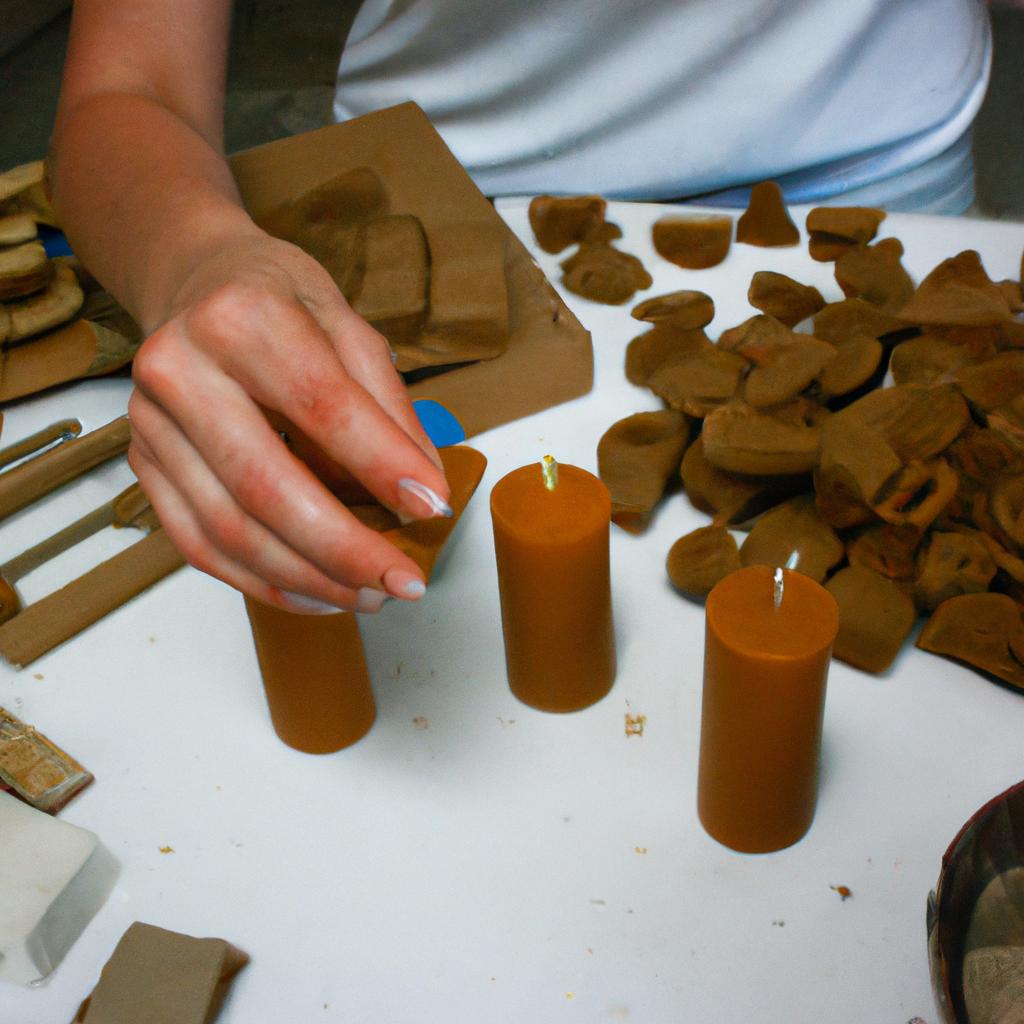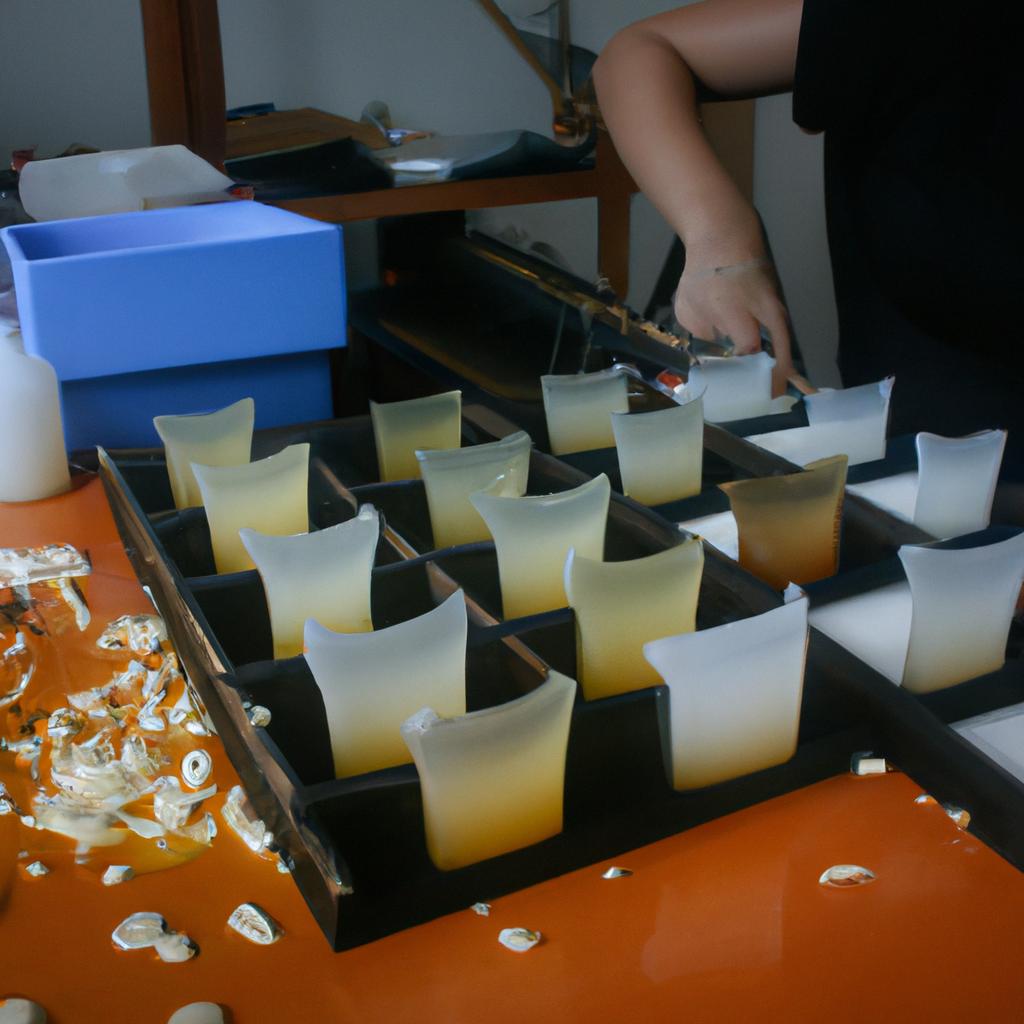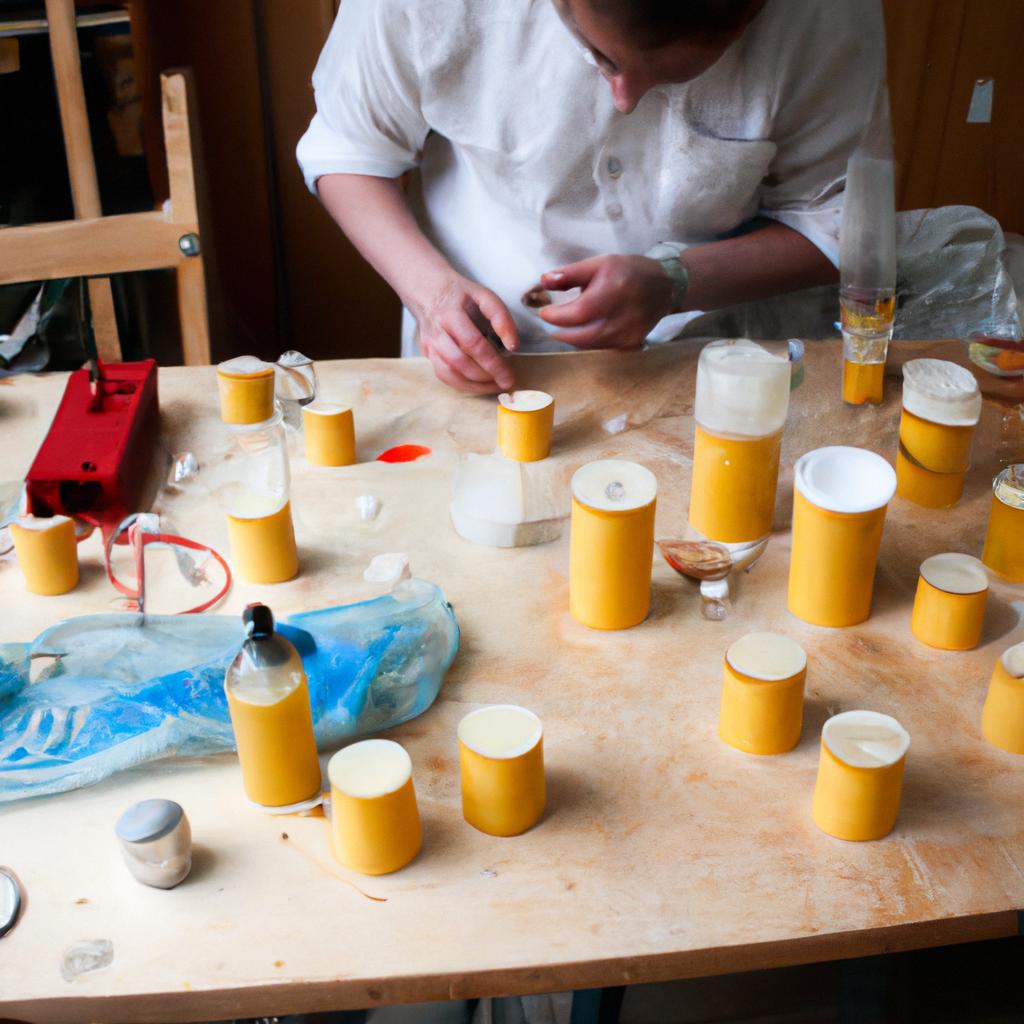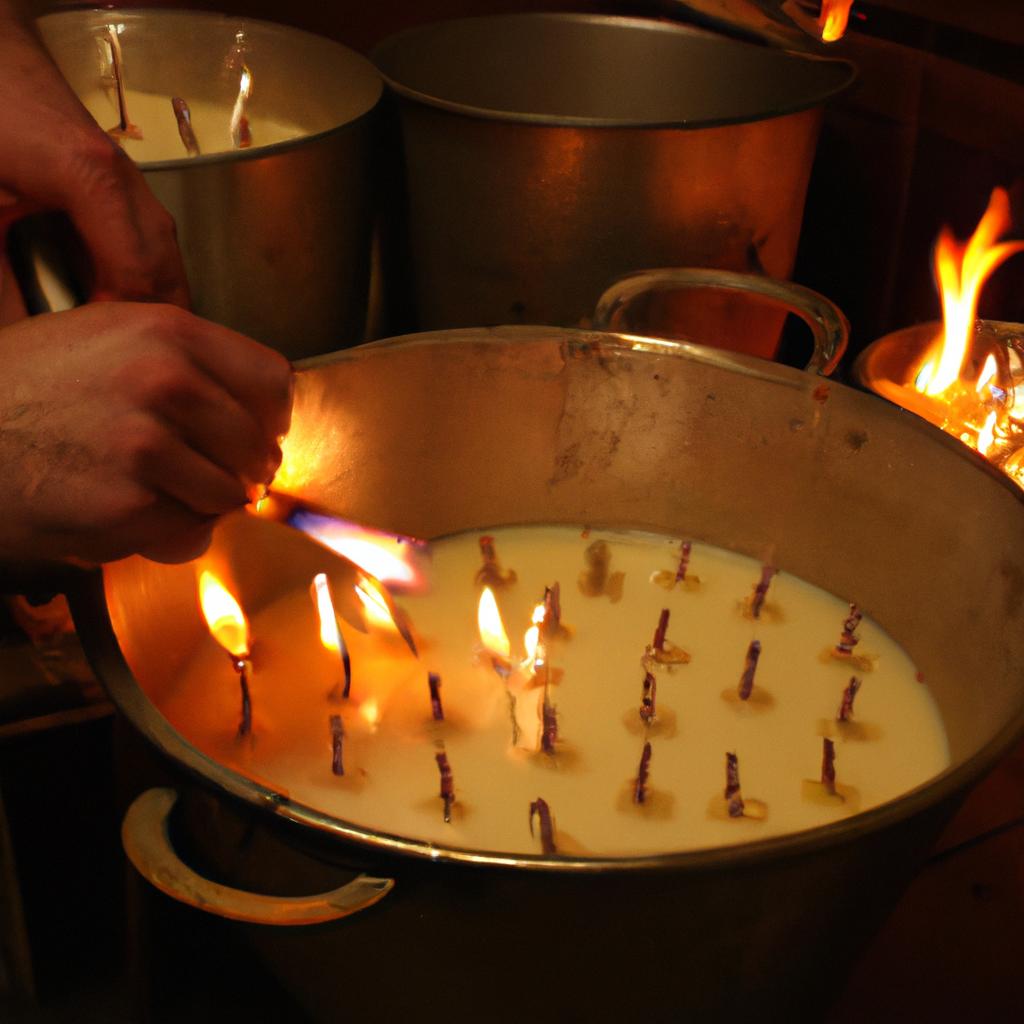Tealight Molds: Essential Tools for Candle Making
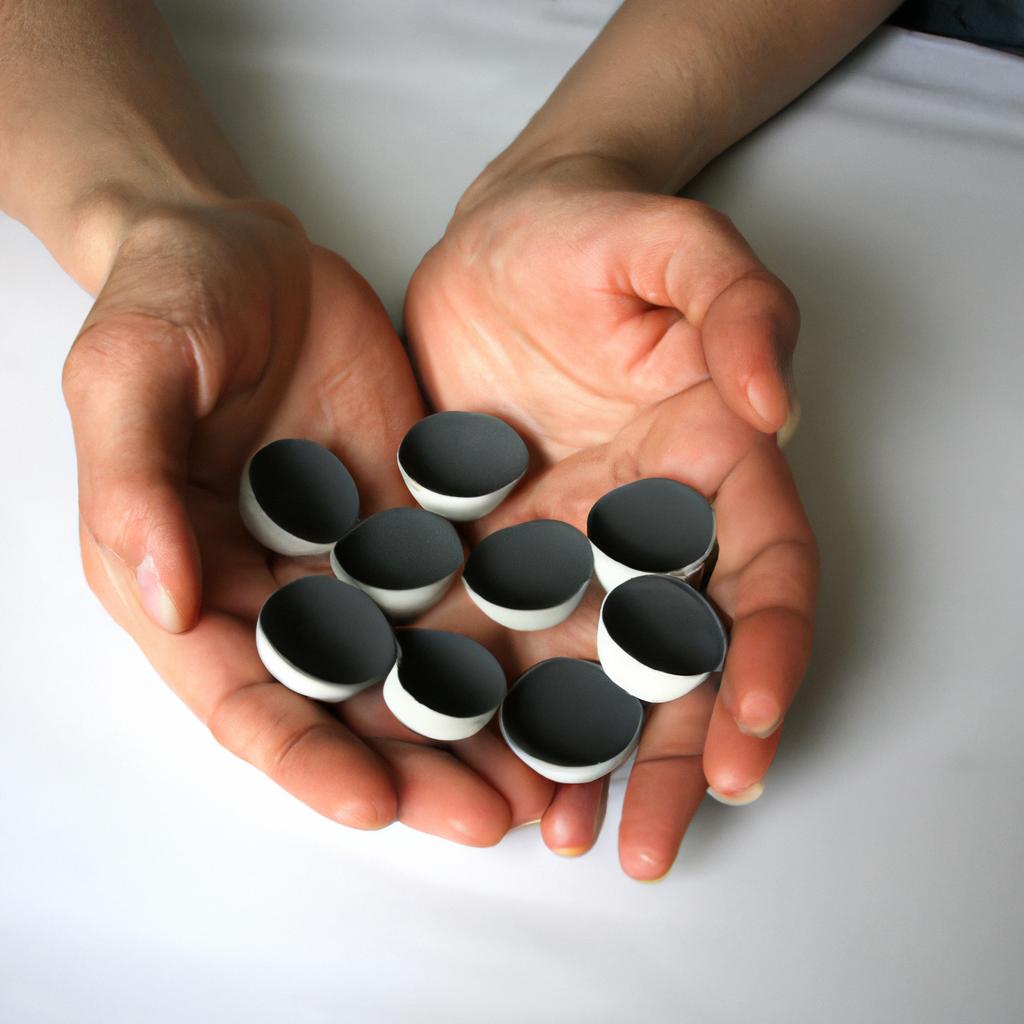
Tealight molds are indispensable tools for candle making enthusiasts, allowing them to create uniform and aesthetically pleasing tealights. These small but mighty molds play a crucial role in shaping the final product, ensuring consistent size and burn time. For instance, imagine a passionate candle maker named Sarah who wants to create a set of tealights as gifts for her friends. Without proper molds, she would struggle to achieve consistent results, resulting in uneven sizes and varying burn times among the candles. However, with the aid of tealight molds, Sarah can effortlessly produce a collection of identical-sized candles that burn uniformly, elevating both their visual appeal and functional performance.
In addition to providing consistency in shape and burn time, tealight molds offer various other benefits within the realm of candle making. First and foremost, these specialized tools facilitate ease of use by simplifying the pouring process. By pouring melted wax into precision-engineered molds specifically designed for tealights, artisans like Sarah can avoid messy spills or imprecise measurements often encountered when using alternative methods such as free-pouring or makeshift containers. As a result, they save valuable time and resources while achieving professional-level outcomes.
Furthermore, tealight molds enable creative exploration through customization possibilities. With an array of mold designs available in the market, candle makers can experiment with different shapes, textures, and patterns to add a personal touch to their tealights. Whether they prefer classic cylindrical molds or opt for unique designs like hearts, flowers, or even seasonal motifs, these molds allow artisans to unleash their creativity and produce one-of-a-kind candles that stand out from the crowd. Additionally, some tealight molds offer options for embedding decorative elements such as dried flowers, herbs, or glitter within the candles, further enhancing their visual appeal.
Tealight molds also contribute to the overall safety of candle making. With their snug fit and heat-resistant materials, these molds ensure proper containment of the melted wax during the burning process. This feature minimizes the risk of accidental spills or flames spreading beyond control. Additionally, some tealight molds come with built-in features like metal wick pins or pre-drilled holes for easy insertion and centering of wicks. These elements help maintain an even burn and prevent potential hazards associated with poorly positioned wicks.
Lastly, tealight molds are reusable tools that offer long-term cost savings and environmental benefits. Made from durable materials such as silicone or aluminum, these molds can withstand repeated use without losing their shape or functionality. By opting for reusable molds instead of disposable alternatives like plastic cups or trays, candle makers reduce waste generation and contribute to a more sustainable approach to crafting.
In summary, tealight molds play an essential role in candle making by providing consistency in size and burn time while facilitating ease of use and creative exploration. They enhance safety measures during burning and offer environmental advantages through reusability. As Sarah embarks on her tealight-making journey armed with these indispensable tools, she can confidently create stunning candles that not only captivate visually but also deliver a delightful sensory experience for her friends to enjoy.
Why Tealight Molds are Necessary for Candle Making
Tealight candles are a popular choice for adding ambiance to any space. Their small size, affordability, and versatility make them a favorite among candle enthusiasts. However, achieving the perfect tealight candle requires more than just pouring wax into a container. Tealight molds play an essential role in candle making by ensuring consistent shape and size, improving burn time, and allowing for easy removal of the finished product.
To illustrate the importance of using tealight molds, let’s consider a hypothetical scenario: Sarah is an avid candle maker who sells her creations at local craft fairs. She decides to experiment with different methods of creating tealight candles to see if there is a noticeable difference in quality. In one batch, she pours melted wax directly into a shallow dish without using any molds. In another batch, she uses professional-grade aluminum tealight molds specifically designed for this purpose.
The results of Sarah’s experiment clearly highlight why tealight molds are necessary for candle making. Without using molds, the candles poured directly into the dish lacked uniformity in both shape and size. This inconsistency not only affects their aesthetic appeal but also impacts their burning performance. On the other hand, when using proper tealight molds, Sarah achieves perfectly shaped candles that fit snugly into standard-sized holders. The even distribution of wax allows for longer burn times and ensures each candle lasts as intended.
Using tealight molds offers several advantages over alternative methods:
- Consistency: Tealight molds provide a standardized shape and size for every candle produced.
- Professional appearance: Molds create smooth edges and clean lines, enhancing the overall visual appeal.
- Ease of use: With pre-made cavities in place, filling the mold becomes quick and straightforward.
- Easy removal: Once cooled and solidified, removing candles from sturdy molds is effortless compared to trying to extract them from makeshift containers or dishes.
In summary, utilizing tealight molds significantly improves the outcome of candle making endeavors. These molds ensure consistent shape and size, enhance the candles’ appearance, simplify the production process, and allow for easy removal of the finished product. The next section will explore different types of tealight molds available in the market, further expanding on their benefits and features.
Different Types of Tealight Molds
Tealight molds are essential tools for candle making due to their numerous advantages. They provide a convenient and efficient way to create tealight candles with consistent shapes and sizes. In this section, we will explore the different types of tealight molds available in the market.
One popular type of tealight mold is the aluminum cup mold. These molds are made from high-quality aluminum, which ensures even heat distribution during the melting and solidification process. The smooth surface of these molds allows for easy removal of the finished candles without any damage or distortion. Additionally, aluminum cup molds have a longer lifespan compared to other materials, making them a cost-effective choice for candle makers.
Another commonly used tealight mold is the polycarbonate plastic mold. These molds are lightweight yet durable, providing stability during the pouring and cooling stages of candle making. The transparent nature of polycarbonate plastic allows candle makers to monitor the progress of their candles easily. Furthermore, they are resistant to cracking and breaking, ensuring that your tealights maintain their shape throughout use.
Silicone molds have also gained popularity among candle makers in recent years. These flexible molds offer versatility in terms of design options since silicone can be molded into intricate patterns or shapes effortlessly. Silicone molds are known for their non-stick properties, enabling easy removal of finished candles without requiring additional release agents such as oils or sprays.
When choosing a tealight mold, it’s important to consider factors such as durability, ease of use, and desired shape options. Below is a comparison table highlighting some key features:
| Material | Durability | Ease of Use | Design Options |
|---|---|---|---|
| Aluminum | High | Easy | Limited |
| Plastic | Medium | Moderate | Moderate |
| Silicone | High | Easy | Extensive |
As you can see from the table above, each material has its strengths and weaknesses. Consider your specific needs and preferences to determine which type of tealight mold would best suit your candle making endeavors.
Choosing the Right Material for Tealight Molds
Section H2: Different Types of Tealight Molds
In the previous section, we explored the different types of tealight molds available for candle making. Now, let’s delve deeper into the importance of choosing the right material for these molds.
Imagine you are a passionate candle maker looking to expand your product range by introducing scented tealights. You have two options for tealight molds – aluminum and silicone. Upon conducting thorough research on both materials, you discover some key differences that can significantly impact your candle-making process and end products.
When it comes to heat conductivity, aluminum molds excel in distributing heat evenly throughout the mold. This ensures that your candles cool down uniformly and prevents any unevenness or warping in their shape. On the other hand, silicone molds tend to insulate heat better, resulting in slower cooling times but also minimizing any potential cracking or imperfections caused by rapid temperature changes.
To further illustrate this comparison between aluminum and silicone molds, let’s take a look at a few key factors:
- Heat Distribution: Aluminum provides efficient heat distribution due to its high thermal conductivity.
- Durability: Silicone molds have greater flexibility and durability compared to aluminum ones, allowing for easy removal of finished candles without damage.
- Ease of Cleaning: Both materials are relatively easy to clean; however, silicone molds often require less effort as wax residue tends not to stick as strongly.
- Affordability: Aluminum molds generally come at a lower cost than silicone molds, making them more budget-friendly for candle makers just starting out.
Consider these aspects carefully when selecting your tealight mold material based on your specific needs and preferences. Whether you prioritize heat distribution, ease of use, or affordability will depend on the goals you have set for yourself as a candle maker.
As we move forward into our next section about “Tips for Using Tealight Molds Effectively,” keep these considerations in mind as they will help you make informed decisions when working with tealight molds and ensure the best results for your candle-making endeavors.
Tips for Using Tealight Molds Effectively
Transitioning from the previous section on choosing the right material for tealight molds, let us now delve into tips and techniques for using these molds effectively. To illustrate their importance, consider a hypothetical scenario where a candle maker named Sarah is struggling to achieve consistent results with her tealights. Despite using high-quality materials, she finds that some of her candles have uneven surfaces or burn too quickly. In this section, we will explore key strategies to overcome such challenges and create beautifully crafted tealights.
To begin, here are several practical tips to enhance your experience when working with tealight molds:
- Prevent leakage: Before pouring wax into the mold, ensure it is tightly sealed to prevent any potential leakage during the cooling process.
- Maintain proper wicking: Choose a suitable-sized wick according to the diameter of your mold. A wick that is too thin may result in an incomplete melt pool, while one that is too thick can cause excessive heat and rapid burning.
- Allow adequate cooling time: After pouring hot wax into the mold, allow sufficient time for it to cool and solidify completely before attempting to remove the tealights. This step ensures smooth removal without damaging the shape or surface integrity.
- Experiment with fragrances and colors: Tealights offer an excellent opportunity for creative experimentation with scents and dyes. Consider adding fragrance oils or colorants to customize your candles as desired.
Now let’s take a closer look at how different factors can influence the final outcome of your tealights by examining them in a table format:
| Factors | Impact |
|---|---|
| Wax type | Determines melting point, scent throw, and burn duration |
| Mold design | Influences overall aesthetics and ease of release |
| Pouring technique | Affects evenness of filling and reduces air bubbles |
| Cooling environment | Impacts consistency in texture and surface appearance |
By considering these factors and implementing the aforementioned tips, you can enhance your tealight-making process significantly. With practice, you will be able to create consistent, high-quality candles that meet your desired specifications.
Transitioning now into the subsequent section about common mistakes to avoid when using tealight molds, it is crucial to understand potential pitfalls in order to achieve optimal results.
Common Mistakes to Avoid When Using Tealight Molds
Transitioning from the previous section’s discussion on effectively using tealight molds, let us now explore some common mistakes to avoid when utilizing these molds. By understanding and avoiding these pitfalls, candle makers can ensure a smoother and more successful candle-making process.
Imagine this scenario: Sarah is an aspiring candle maker who recently purchased tealight molds to enhance her craft. Excited about creating beautiful candles, she dives right into the process without taking note of potential errors that could occur along the way. Unfortunately, Sarah soon encounters several challenges that hinder her progress.
To prevent others from experiencing similar setbacks, here are some key tips for using tealight molds effectively:
-
Select appropriate wick sizes: Choosing the correct wick size is crucial in ensuring proper burning performance for your tealights. A too-thin wick may result in incomplete melting or extinguishing before complete consumption, while a too-thick wick might cause excessive smoke or uneven burning. Consider consulting a reliable guide or conducting small test batches to determine the most suitable wick size for your specific tealight mold dimensions.
-
Control pouring temperature: The temperature at which you pour the wax plays a significant role in achieving quality results with your tealights. Pouring wax that is either too hot or too cold can lead to issues such as poor adhesion within the mold or improper fragrance release during burning. It is advisable to experiment with different pouring temperatures until you find the optimal range that yields consistent outcomes.
-
Practice patience during cooling phase: Rushing through the cooling phase after pouring the melted wax into the molds can have adverse effects on your final product. Prematurely removing tealights from their molds may result in deformation, cracking, or even breakage due to insufficient solidification. Allow ample time for complete cooling and hardening before attempting to remove them gently from their respective molds.
To further emphasize these crucial tips, consider the following emotional appeal:
- Increased customer satisfaction: By ensuring proper wick selection and pouring temperature control, your tealights will burn evenly and emit pleasant fragrances. This enhances customers’ overall experience, leading to higher satisfaction levels.
Now let us delve into a table that summarizes these key tips along with their corresponding benefits:
| Tips | Benefits |
|---|---|
| Select appropriate wick sizes | Ensures even burning performance |
| Control pouring temperature | Promotes successful adhesion and fragrance release |
| Practice patience during cooling | Prevents deformations or breakages |
By adhering to these tips when using tealight molds, candle makers can enhance their craftsmanship while minimizing potential errors. In the subsequent section about “Cleaning and Maintaining Tealight Molds,” we will explore how to extend the lifespan of these essential tools through proper care and maintenance.
Cleaning and Maintaining Tealight Molds
Tealight molds are indispensable tools for candle making, allowing you to create beautiful and uniform tealights. In the previous section, we discussed common mistakes to avoid when using these molds. Now, let us delve into another important aspect of working with tealight molds – cleaning and maintaining them properly.
To illustrate the significance of this topic, consider a scenario where a candle maker neglects proper cleaning and maintenance of their tealight molds. Over time, residue from previous candles builds up in the molds, affecting the quality and appearance of new tealights. This can result in uneven burning, difficulty in removing finished candles from the molds, and ultimately lead to dissatisfaction among customers.
To ensure optimal performance and longevity of your tealight molds, here are some essential cleaning and maintenance tips:
-
Regular Cleaning: After each use, clean your molds thoroughly to remove any leftover wax or debris. You can do this by gently washing them with warm water and mild soap. Avoid using abrasive materials that may damage the mold’s surface.
-
Inspect for Damage: Periodically inspect your tealight molds for any signs of wear or damage such as cracks or dents. Damaged molds can affect the shape and quality of your candles. If you notice any issues, it is advisable to replace them promptly.
-
Lubrication: Apply a thin layer of mold release spray or oil before pouring wax into your tealight molds. This helps facilitate easy removal of finished candles without causing any damage to the mold.
-
Storage: Properly store your tealight molds in a cool and dry place away from direct sunlight or extreme temperatures. This prevents warping or distortion which could affect the final product.
By following these guidelines diligently, you will not only prolong the lifespan of your tealight molds but also maintain consistent results in terms of candle quality and customer satisfaction.
Cleaning and maintaining tealight molds is an essential part of successful candle making practice. By ensuring cleanliness, inspecting for damage, applying lubrication, and storing them properly, you can enjoy the benefits of these molds for a long time to come. So take care of your tealight molds, and they will continue to assist you in creating beautiful candles that bring warmth and ambiance into people’s lives.



